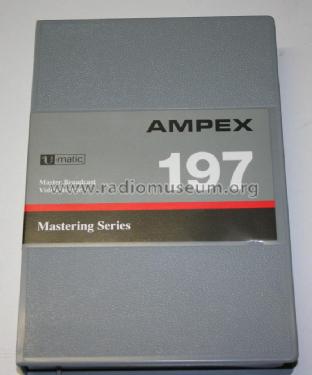U-Matic Videocassette All
Ampex; San Carlos, CA
- Country
- United States of America (USA)
- Manufacturer / Brand
- Ampex; San Carlos, CA
- Year
- 1971
- Category
- Miscellaneous (Other, Various) - see notes
- Radiomuseum.org ID
- 264727
- Wave bands
- - without
- Details
- Special Tape or Cassette-Format
- Power type and voltage
- No Power needed
- Loudspeaker
- - - No sound reproduction output.
- Material
- Plastics (no bakelite or catalin)
- from Radiomuseum.org
- Model: U-Matic Videocassette [All] - Ampex; San Carlos, CA
- Shape
- Miscellaneous shapes - described under notes.
- Notes
-
This page is for all AMPEX labeled U-Matic type Video Cassette Tapes for all TV standards (Low- & Hi Band version).
Please do not modify this page.
Load only pictures with all data in the picture legend!
Bitte nur Bilder hochladen, alle Informationen/Daten in die Bildlegende.
History (Extracts taken from Wikipedia):
"U-matic is an analog recording videocassette format first shown by Sony in prototype in October 1969, and introduced to the market in September 1971.
It was among the first video formats to contain the videotape inside a cassette, as opposed to the various reel-to-reel or open-reel formats of the time.
Unlike most other cassette-based tape formats, the supply and take-up reels in the cassette turn in opposite directions during playback, fast-forward, and rewind: one reel would run clockwise while the other would run counter-clockwise. A locking mechanism integral to each cassette case secures the tape hubs during transportation to keep the tape wound tightly on the hubs. Once the cassette is taken off the case, the hubs are free to spin. A spring-loaded tape cover door protects the tape from damage; when the cassette is inserted into the VCR, the door is released and is opened, enabling the VCR mechanism to spool the tape around the spinning video drum. Accidental recording is prevented by the absence of a red plastic button fitted to a hole on the bottom surface of the tape; removal of the button disabled recording.
As part of its development, in March 1970, Sony, Matsushita Electric Industrial Co. (Panasonic), Victor Co. of Japan (JVC), and five non-Japanese companies reached agreement on unified standards.
The videotape was 3⁄4 in (1.9 cm) wide, so the format is often known as 'three-quarter-inch' or simply 'three-quarter', comparing to other open reel videotape formats of the same vintage, such as 1 in (2.5 cm) type C videotape and 2 in (5.1 cm) quadruplex videotape. The first generation of U-matic VCRs were large devices, approximately 30 in (76 cm) wide, 24 in (61 cm) deep, and 12 in (30 cm) high, requiring special shelving, and had mechanical controls limited to Record, Play, Rewind, Fast-Forward, Stop and Pause (with muted video on early models).
Later models sported improvements such as chassis sized for EIA 19-inch rack mounting, with sliding rack rails for compressed storage in broadcast environments, solenoid control mechanics, jog-shuttle knob, remote controls, Vertical Interval Time Code (VITC), longitudinal time code, internal cuts-only editing controls, "Slo-Mo" slow-motion playback, and Dolby audio noise reduction.
U-matic was named after the shape of the tape path when it was threaded around the helical scan video head drum, which resembled the letter U.
Betamax used this same type of "U-load" as well. Recording time was limited to one hour.
... Sony shifted U-Matic's marketing to the industrial, professional, and educational sectors. U-Matic saw even more success from the television broadcast industry in the mid-1970s, when a number of local TV stations and national TV networks utilized the format when its first portable model, the Sony VO-3800, was released in 1974. This model ushered in the era of ENG, or Electronic News Gathering, which eventually made obsolete the previous 16mm film cameras normally used for on-location television news gathering. Film required developing which took time, compared to the instantly available playback of videotape, making faster breaking news possible."
- Author
- Model page created by a member from A. See "Data change" for further contributors.
- Other Models
-
Here you find 84 models, 81 with images and 19 with schematics for wireless sets etc. In French: TSF for Télégraphie sans fil.
All listed radios etc. from Ampex; San Carlos, CA
Collections
The model U-Matic Videocassette is part of the collections of the following members.

